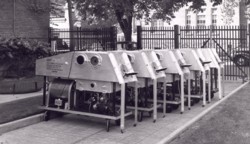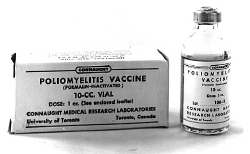POLIOMYELITIS IN CANADA, 1927-1962
© 1995 Christopher J. Rutty
Photocopies of this Thesis (452 pp.) are available (double-sided cirlox bound) for $45.00, postage included, from the address below.

Iron Lungs, Hospital for Sick Children |

Poliomyelitis Vaccine (Salk), Connaught Medical Research Laboratories, University of Toronto, 1959. Photo: Aventis Pasteur Limited Archives, Acc0282 |
This dissertation explores the factors underlying such government involvement, especially the unique nature and personal experience of polio, its frightening imagery, the press' role in its management, and -- within a context of high public expectations for protection -- the profound medical, public health and scientific frustrations associated with its understanding, diagnosis, prevention, control, treatment and after- care. Of primary significance was polio's visibility, unpredictability and variability . Moreover, its primary target was young children, especially middle class children. Growing numbers of adult cases and the high costs of its short and long-term management to families, institutions and governments compounded polio's dramatic impact, especially during the post-war "baby boom."
Expanding government intervention was the most distinctive feature separating the Canadian polio experience from the American's, although its evolution had important American influences. In particular, the conjunction of American enthusiasm for a series of hopeful polio "weapons" with major Canadian epidemics had a direct impact on the growth of provincial polio services. The most powerful force on governments and voluntary efforts north of the border was the National Foundation for Infantile Paralysis ("March of Dimes"), with its unprecedented publicity, fundraising, patient care and polio research efforts. There were, however, important influences from north to south. Financed by American dimes, and by significant Canadian funding, comprehensive polio research efforts at Connaught Medical Research Laboratories at the University of Toronto proved critical to the development and unprecedented American trial of the Salk vaccine, and the ultimate control of this disease.
Chapter 1: Medical, Political and Popular Background to 1927
1.2) The Enigma of Poliomyelitis: Polio and Medical Science to 1927
1.3) Polio and Physicians to 1927
1.4) Canadian Public Health and the State to 1927
1.5) Disease and the Mass Media to 1927
2.2) Convalescent Serum, Publicity and the State
2.3) The Provinces and Paralysis Management
3.2) Second Wave Epidemics and the Provincial Response, 1936-37
3.3) Medical Science, Technology and Crisis Management:
b) "Miraculous Metal Monsters"
4.2) The Sister Kenny Revolution in Canada, 1941-46
4.3) The Polio Challenge and Rising Federal Interest, 1946-47
5.2) Polio and Canadian Voluntary Organizations to 1948
5.3) "Don't Panic Over Polio!" The Canadian "March of Dimes" and the Politics of Polio, 1948-52
6.2) Politics, Policies and the High Costs of Polio, 1952-53
6.3) "The Summer of Fear" The National Polio Crisis of 1953
7.2) Polio Investigations, Research Funding and the Building of a Canadian Virus Laboratory, 1947-49
7.3) Epidemiology, Canadian Research Experience and Eskimo Polio, 1949-51
7.4) The Money, the Medium and the Methods: Polio Immunity, Virus Cultivation, and American Dimes, 1949-53
8.2) Ottawa, the Provinces, and the Salk Vaccine, 1954-55
8.3) Triumph, Tragedy and Canadian Lessons
Conclusions: The Meaning, Lessons and Legacy of Polio in Canada
Appendix: Figure and Tables
Bibliographic Essay
Bibliography
Biographical Sketch
| Christopher J. Rutty, Ph.D.
HEALTH HERITAGE RESEARCH SERVICES 96 Durie Street. Toronto, Ontario, Canada M6S 3E9 416-769-7948 hhrs@healthheritageresearch.com http://www.healthheritageresearch.com |